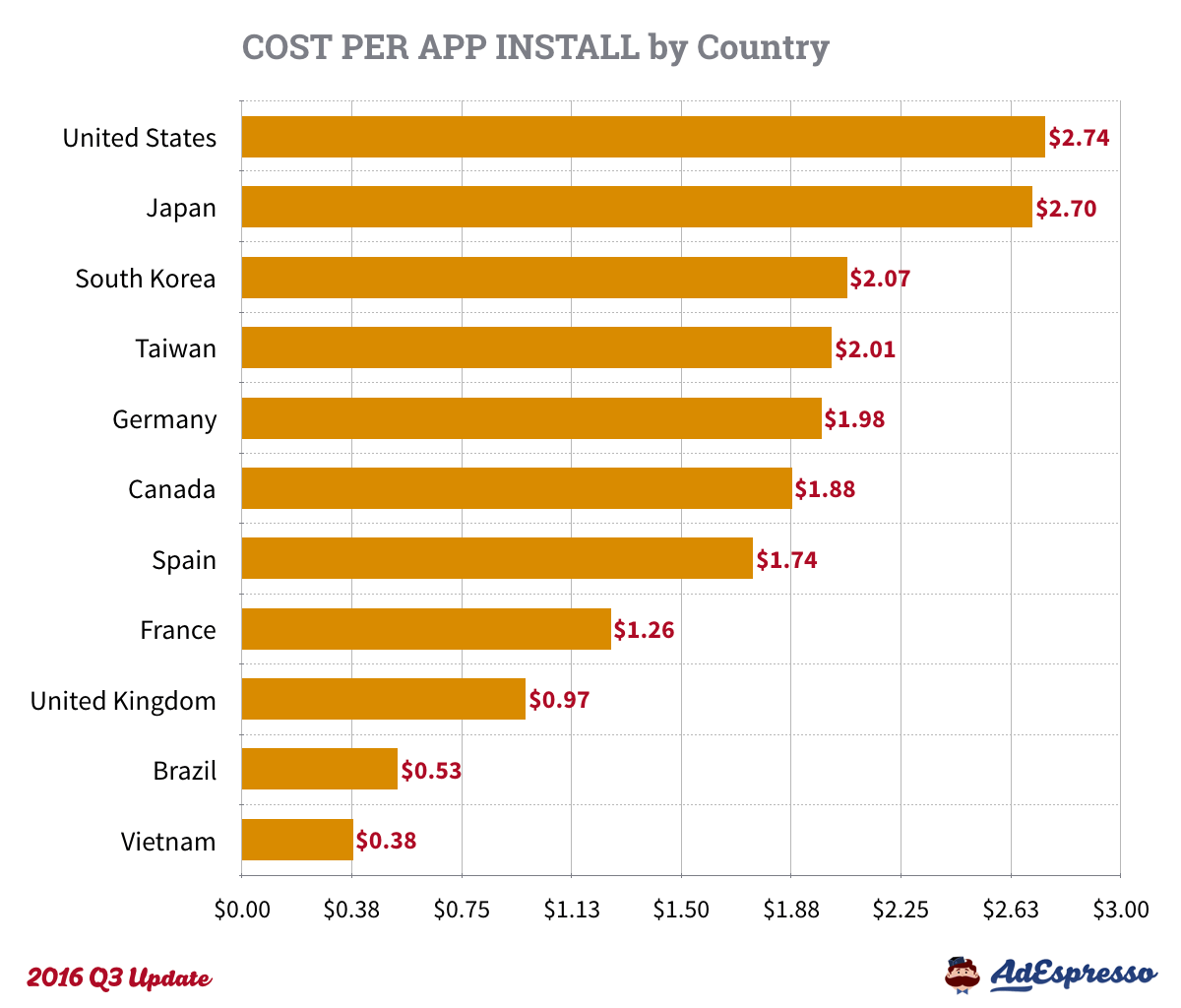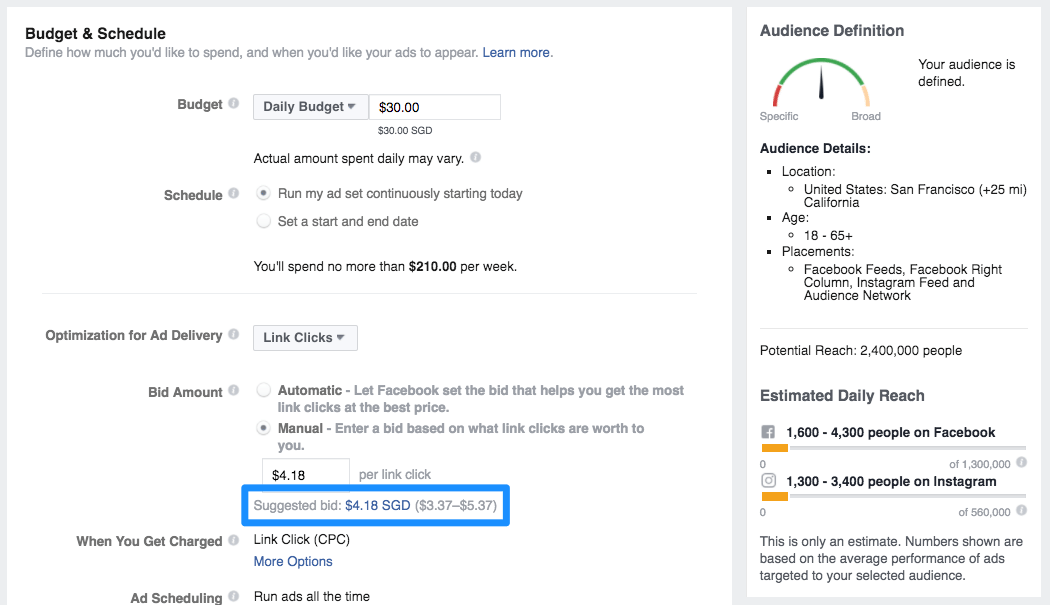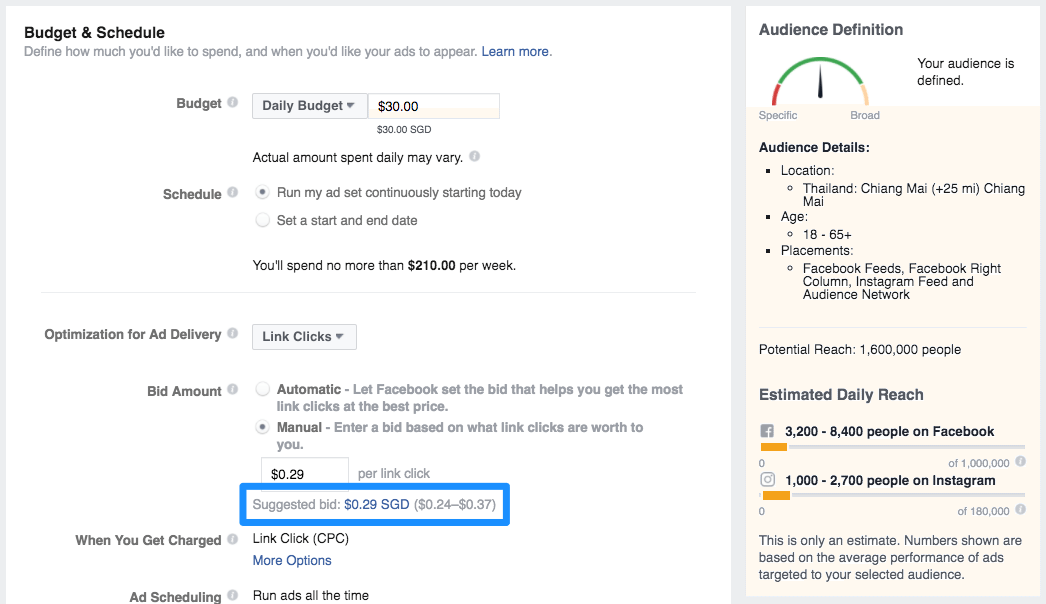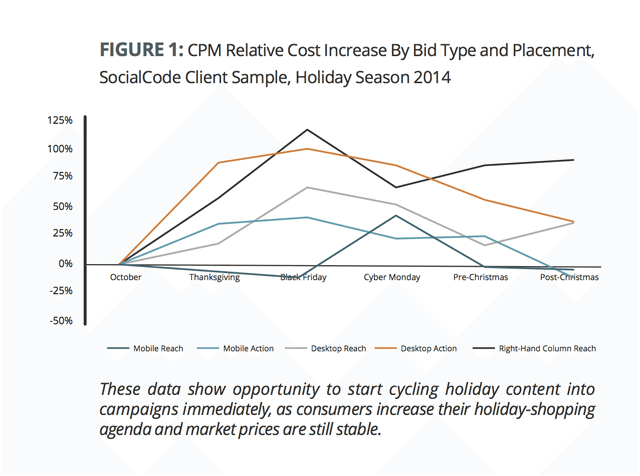We previously shared what $5 per day will buy you on Facebook Ads, but how much does Facebook advertising really cost?
That’s a tricky question! And the short answer is, it’ll never cost you more than you have to spend. If you have a budget of $5 per day, Facebook Ads will never cost you more than $5 a day. However, there are a number of factors that will affect how far your budget will stretch and the success you’ll see for your money.
Maybe a better approach with Facebook Ads could be to think about how you can make your budget deliver the best results for your business. And that’s precisely where I’d love to help you today.
In order to help you understand exactly how to optimize your Facebook Ads spend for the best results, I dug into several Facebook resources and studies to identify some Facebook advertising benchmarks and along the way, I also discovered seven key factors that determine the cost of Facebook Ads, which I’m excited to share with you.
In this post, we’ll give you everything you need to know about the cost of Facebook Ads and how to make your budget work for you.
Ready to read on?
Let’s go…
Plan, schedule, and analyze your posts to Facebook Pages and Groups with Buffer's Facebook scheduling and analytics tools.
Benchmarks: How much does Facebook advertising cost?
You might be curious about the exact cost of an impression, a click, or a conversion through Facebook ads. However, as many factors influence the cost of Facebook advertising, there isn’t an absolute answer to this question.
Thankfully, Facebook Marketing Partners like AdEspresso, SalesForce, and Nanigans regularly analyze social media advertising spend. While the benchmarks will not tell you precisely how much your Facebook ad campaign will cost, they might be great reference points for your consideration.
The team at AdEspresso seem to have the most up-to-date benchmarks at the moment. They studied over 100 million dollars of ad spend in 2016 Q3 and came up with a set of benchmarks for the current cost of Facebook advertising. Here are a few of their findings (the currency is in U.S. dollars):
- The average Cost Per Click (CPC) is about $0.35 globally and about $0.28 in the U.S.
- The average cost per like is $0.23 in the U.S.
- The average cost per app install is $2.74 in the U.S.
And here’s the data from AdEspresso’s study:
Cost per click (CPC) by country

Cost per Like by country

Cost per app install by country

Editor’s note: We chose to highlight AdEspresso’s data here as it was the most up-to-date study we found (data from Q3 2016), feel free to check out and compare the full reports by AdEspresso, SalesForce, and Nanigans.
How does Facebook decide whether to show your ads? (And why the biggest budget doesn’t always win)
Now that we’ve established some benchmarks on how much Facebook advertising costs, it might be helpful to understand how Facebook ads system works — in other words, how Facebook decides which ads to show each of its users.
When showing ads, we try to balance two things:
- Creating value for advertisers by helping them reach and get results from people in their target audiences
- Providing positive, relevant experiences for people using Facebook, Instagram or Audience Network
The best way for us to do this is to hold an auction in which both interests are represented. That way, advertisers are reaching people receptive to their ads and users are seeing something they’re interested in. This is different than a traditional auction because the winner isn’t the ad with the highest monetary bid, but the ad that creates the most overall value.
So, whenever there is an ad space available, Facebook will batch together all of the ads vying for that specific space and auction the spot, with the winner of the auction having their ad shown to the end user. Billions of these auctions take place everyday.
How does the Facebook ads auction process work?
Unlike a traditional auction, Facebook advertising space is not won with the highest monetary bid. This is because Facebook wants to provide a positive, and importantly, relevant experience for all of its users. As such, the winner of an auction is decided by the overall value created by the ad for the targeted user.
Facebook determines the potential value created by each ad by analyzing three factors:
- Advertiser bid – representing how interested you are in showing your ad.
- Ad quality and relevance – decided by how interested Facebook thinks a person will be in seeing your ad.
- Estimated action rates – calculated by how likely Facebook thinks a person will take the action you are optimizing for with your ad (for example visiting your website or downloading your app).
Whenever there’s ad real estate on Facebook up for auction, Facebook will combine the three factors into a total value and display the ad with the highest value. This means that you don’t need to have the highest bid each time to have your ad shown if your ad is of higher quality and relevance than your competitors.
After the auction is won, Facebook considers all the ads competing for that ad space and charges the winning ad the minimum amount that’s required to win the auction (meaning you won’t always be charged your maximum bid for ads on Facebook).
7 Factors that determine the cost of Facebook Ads
1. Your Bid: How interested you are in showing your ad
When you create a Facebook Ad, you’re basically joining a huge, global auction, competing with other advertisers for ad space on Facebook.
Your bid amount represents how interested you are in showing your ad and the higher your bid, the more likely your ad will be shown. When creating your Facebook, you can set your bid automatically or manually.

Here’s a quick breakdown of both options:
Automatic bid: If you choose automatic, Facebook decides the bid amount for you. The bid is set so that Facebook would spend your entire ad budget with the goal of maximizing the result you want. If you are unsure how much to bid, Facebook recommends choosing this option.
Manual bid: If you choose manual bid, you tell Facebook the maximum amount you’d be willing to spend to achieve the result you want (e.g. $5 for a click).
When you think about how much to bid, it’s worth keeping in mind these couple of tips from AdEspresso:
- If you try to bid too low, your campaign may not get the exposure it deserves, and you won’t reach your goals. Remember, you always get what you pay for.
- Don’t worry about bidding a high amount. You’ll still end up paying the lowest amount possible in the auction to get your ads delivered.
2. Ad Quality and Relevance: How interested a person will be in seeing your ad
Facebook estimates the quality and relevance of your ad based on how it’s performing. Facebook considers both positive (e.g. number of clicks, video views, or app installs) and negative feedback (e.g. number of people who clicked “I don’t want to see this” on your ad) to decide the quality and relevance of every advert.
To help you understand how relevant your ad is to your target audience, Facebook provides a Relevance Score metric for each of your ads. When your ad’s relevance score is high, Facebook will show your ad more than ads with lower relevance scores, and you will also pay less to reach more of your target audience.
You can find your ad’s relevance score and level of positive and negative feedback in your Facebook Ads Manager.

3. Estimated Action Rates: How likely a person will act on your ad
When deciding whether to show your ad to a person in your target audience, Facebook estimates how likely the person will take the action you are optimizing for with your ad (this is called Estimated Action Rate).
For example, if you’re running an ad for your marketing tool (like Buffer) that’s optimized for website conversions, Facebook would show your ad to people it deems likely to sign up for a product like yours. Facebook determines this based on the previous actions of the person in your target audience (“how many times has she signed up for a product through a Facebook ad?”) and your ad’s previous performance (“how many website conversions has your ad received so far?”).
If your Estimated Action Rate is low, my hunch is that the cost of your Facebook ads will be high. To make sure your ad wins some ad auctions and is shown to your target audience, Facebook might have to compensate your ad’s low Estimated Action Rate by increasing your bid (if you have chosen automatic bid).
According to Facebook,
To help us make our estimations as accurate as possible, we recommend setting your budget and bid high enough to get at least a few of the results you want per day (especially for results that take place off-site like website conversions and mobile app events).
4. Your Audience Targeting: Who and how many people you are trying to reach
Who you target and how many people you target will influence your Facebook advertising cost. This is due to the level of competition to reach a particular audience. When more marketers are targeting a specific audience, it becomes more expensive to reach them.
To test this out, I ran a quick experiment by creating two ad sets that are identical except for the audience location — I set one for Chiang Mai, Thailand and the other for San Francisco, U.S.
The suggested bid when I chose manual bid was $0.29 per click for Chiang Mai and $4.18 per click for San Francisco, meaning it’s more than 14 times more expensive to target an audience in San Francisco than Chiang Mai:


Apart from location, the following audience details may also affect the cost of your ads:
- Age
- Gender
- Languages
- More specific demographics, interests, or behaviors
- Connections (with your Facebook Page, app, or event)
I’d recommend experimenting with various audiences in order to find one that works best for your Facebook Ads campaigns.
5. Time of The Year: How many people are buying Facebook ads
When the number of advertisers targeting an audience increases, so does the cost of ads, as Ana Gotter explained on AdEspresso,
There are peak times in the year when advertisers are flocking to Facebook Ads in droves—even more than normal. During these peak times, there will be more competition for ads, and you’ll pay more as a result.
SocialCode also studied the CPM of Facebook ads during the holiday season in 2014 and found that costs increased across different bid types and ad placements.

Facebook Marketing Partners, Ambush and Salesforce both found similar trends while studying data from different years (2013, 2014, and 2015).
If you are thinking of advertising on Facebook during the holiday season, here are the key events to look out for:
- Thanksgiving Day
- Black Friday
- Cyber Monday
- Christmas
- Post-Holiday Sales
- New Year’s Eve
- New Year’s Day
If you’re planning campaigns around these, or other big events, it’s important to think about how the amount of competition may affect the cost of your ads.
6. Placement: Where your ads appear
Placement describes where your ads are shown within Facebook’s ecosystem. The various locations in which you can display ads include:
- Facebook’s desktop News Feed
- Facebook’s desktop right column
- Facebook’s mobile News Feed
- Instagram’s mobile News Feed
- Audience Network
- Messenger

In advising how to maximize Facebook ads results, Facebook recommends that marketers allow Facebook to place their ads on Instagram and Audience Network as well Facebook. Doing so, Facebook says, can reduce the average cost per result of your ad:
Reach more people through Instagram and Audience Network
Allowing us to show your ad on Instagram and the Audience Network as well as Facebook gives you more opportunities to reach the people you care about across devices. It can also reduce your average cost per result. At the ad level of ad creation, make sure you’ve opted into both additional placements and that your ad’s creative complies with the Instagram and Audience Network requirements.
While this sounds great, it might be worth considering if your target audience active on Instagram or if advertising is aligned with your Instagram strategy.
7. Optimization of Ad Delivery: What your ad is optimized for
When creating your ad, if you click on “Show Advanced Options” under “Budget & Schedule”, you will find an option called “Optimization for Ad Delivery”.
Your choice for optimization here can influence who Facebook shows your ads to. For example, if you choose to optimize for clicks, Facebook will show your ad to people who are most likely to click the ad.

This can affect the cost of your ad because actions taken on your ad will affect your ad’s relevance score and estimated action rate (see point two and three above). If your ad is not optimized for the result you want, Facebook might not show your ad to people who are most likely to act positively on your ad and you might even end up paying more for the results.
AdEspresso did an experiment with the different optimization options and found that the choice of optimization can affect the cost of result you are optimizing for. For example, if you want to optimize for clicks, you are usually better off choosing “Link Clicks”.
Why you should consider ROI, not only cost
Instead of focusing purely on the cost of Facebook advertising, it might also be great to look at your return on investment as a key metric.
ROI = (Return – Investment) / Investment
When it comes to Facebook Ads, there are two types of ROI to consider – financial ROI and social ROI:
1. Financial ROI
This form of ROI weighs your investment in Facebook ads against business results such as revenue.
If you are able to measure how much your customers tend to spend, you can determine if each conversion was worth the money spent. For example, paying $10 for a conversion might sound expensive. But if you know that a customer who was converted from a Facebook ad usually spends $50, the $10 is probably worthwhile as you get a five times the return.
Looking at ROI is also helpful when deciding whether you should advertise during price hikes. For instance, cost of Facebook advertising is usually higher during the holiday season. If your sales tend to increase (preferably more than the increase in cost) during this period, it might still be worth investing in Facebook ads. If your sales tend to slow down instead, it might be better to explore other options during this period.
2. Social ROI
Another great type of ROI to consider is social ROI. On top of the revenue you might earn through Facebook ads, you might also generate some interactions on your ads. Social ROI considers the amount of social engagement (likes, comments, and shares) you get from your Facebook ads relative to your investment.
It’d be great to decide how much social engagement is worth to your brand. Here’s a simplified way of calculating your social ROI: if you paid $50 to promote your Facebook post and it received 80 likes, 15 comments, and five shares (100 interactions in total), each interaction costs you $0.50. Is that reasonable for you?
P.S. If you’re interested in reading more about social ROI, here’s a more detailed guide on social media ROI.
Additional resources
- The Complete Resource to Understanding Facebook Ads Cost – 2016 Q3 Results! on AdExpresso by Ana Gotter (Ana shared 6 tips to reduce your Facebook advertising cost in thi post.)
- Facebook ads split testing 101 on AdEspresso by Massimo Chieruzzi
- Guide: Everything you need to know about getting conversions by Facebook
- Avoid under-delivery of your ads by Facebook
Over to You
Wow, so that was quite a long article on the cost of Facebook Ads. Thank you for staying with me throughout the post!
Facebook Ads optimization and cost is a huge topic, and I think we have barely scratched the surface here. It’d be awesome to hear your experiences, too! Feel free to share in the comments below, I’d love to join the conversation.
How do you measure the returns on Facebook advertising?
Do you have any tips for lowering Facebook advertising cost?





